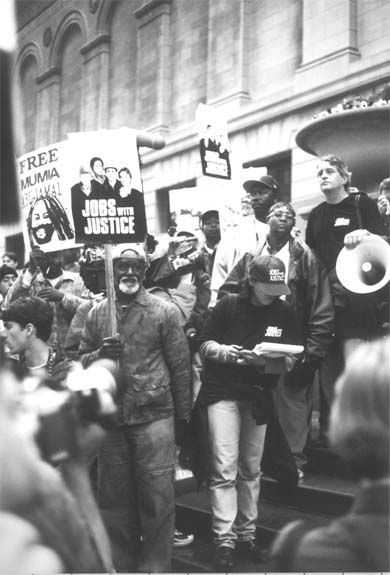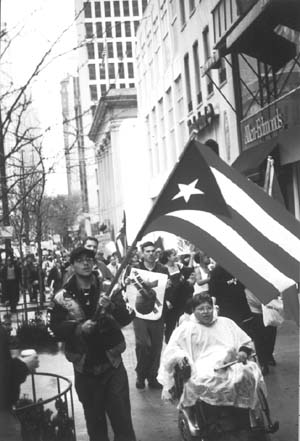People Reclaim the Streets on May Day in
Chicago
-By Kari Lydersen
From the Board of Trade to the gentrifying Puerto Rican and
Mexican neighborhoods of West Town and Humboldt Park to the Chicago Tribune
tower to Daley Plaza to the very spot the Haymarket Martyrs were murdered in
1887, Chicagoans took to the streets on May Day 2000 to commemorate labor struggles
past and present.The first May Day march took place in 1886, when 85,000 workers
marched up Michigan Avenue demanding an eight hour work day. A bomb was supposedly
thrown at police by protesters, though the police version of the story has been
the subject of much doubt, and the Haymarket Martyrs—immigrant anarchists
and activists—were sentenced to death for the crime.
![[Image of Radical Cheerleaders]](../Resources/RadicalCheerleaders.jpg) The Radical Cheerleaders shake a
little booty near the river at Michigan Avenue, part of the demonstration tracing
the path followed by the 1886 demonstration for the eight-hour work day.
The Radical Cheerleaders shake a
little booty near the river at Michigan Avenue, part of the demonstration tracing
the path followed by the 1886 demonstration for the eight-hour work day.
As seen with the Seattle and Washington D.C. demonstrations,
globalization was the primary focus of the various events. Puppets of bloated
and pig-faced corporate businessmen caricatured the greed of multinational corporations,
while speakers from the United Steelworkers of America, the Prison Action Committee,
the Workship Coalition, Latinos Unidos, Youth for Change, Pueblos Sin Fronteras,
SEIU Local 46, the Christian Council on Urban Affairs and countless other groups
told of the effects of the globalization of capital on people around the world.
"The May Day mission was different in several respects
from Seattle and Washington D.C.," said Harold Taggart, an activist who
participated in both the Seattle and D.C. demonstrations. "It addressed
the WTO, IMF and World Bank, but as part of a package of problems. There was
not a single, overriding, tangible ogre for the May Day protests. The villains
had been identified in Seattle and D.C. The May Day protests needed to be geared
more toward education, ramifications and alternatives to the current heartless
and morally bankrupt corporate capitalist system."
The May Day celebrations consisted of several major events
which crisis-crossed and converged in various ways, with most of the groups
coming together for a rally of about 1,000 outside the Tribune Tower in the
early afternoon. Day laborers —many of them undocumented immigrants and
homeless people who have little recourse to protect their rights —marched
up Michigan Avenue from Balbo to the Tribune, where they told stories of abuse
by employers, including not being paid for their work and being stranded in
the suburbs with no money to get home. Their route traced the original 1886
May Day march.
 Mumia
activists join the Service Employees International Union demonstration outside
the Art Institute.
Mumia
activists join the Service Employees International Union demonstration outside
the Art Institute.
At the Art Institute of Chicago, along the march route, union
members and workers also spoke about the union organizing efforts of workers
at the museum, who say they are poorly paid and treated even though the museum
is one of the wealthiest cultural institutions in the country.
 Demands
for amnesty for immigrants and a ban on the continuing bombing of the Puerto
Rican Island of Vieques, as well as freedom for all political prisoners held
in U.S. prisons, were featured in the march which began in Humboldt Park.
Demands
for amnesty for immigrants and a ban on the continuing bombing of the Puerto
Rican Island of Vieques, as well as freedom for all political prisoners held
in U.S. prisons, were featured in the march which began in Humboldt Park.
A march titled Global Crimes, Local Action started at
the corner of Division Street and Western Avenue in the Puerto Rican neighborhood
of Humboldt Park. Members of the Humboldt Park community then marched to the
Division-Ashland intersection in West Town, where they joined with Mexican immigrants
and other West Town immigrants. The march, which was sponsored by the Puerto
Rican Cultural Center, Pueblos Sin Fronteras and the Prairie Fire Organizing
Committee, included demands for unconditional amnesty for immigrants; the release
of all political prisoners; an end to police brutality; an end to sweatshop
labor and the exploitation of women; and the demilitarization of the Philippines
and other countries occupied by the U.S. military, including the withdrawal
of the U.S. Navy from the Puerto Rican island of Vieques. This march, about
300 strong, joined with the other marches at the Tribune plaza.
Meanwhile, outside the Colombian consulate at 500 N. Michigan,
protesters decried the "dirty war" in Colombia, including the U.S.'s
funding of the government's brutal counterinsurgency efforts under the guise
of the war on drugs.
A Critical Mass bike ride took off from Daley Plaza to the
Tribune tower - the bikers highlighted the economic and environmental benefits
of biking instead of driving cars, and also expressed their political views
on globalization.
Other activists, including many anarchists and Black Bloc members,
converged early in the day at the Chicago Board of Trade at LaSalle and Jackson,
where they held some displays of street theater. "It seemed that every
TV station in Chicago was represented at the Board of Trade," said Taggart,
who arrived at the Board at 6 a.m. in the rain for a scheduled interview with
Fox TV News, though the Fox reporters didn't show up at that time. "The
constant question from the media was whether or not violence was anticipated.
We answered in the negative. Civil disobedience was always an option, we reminded
them. As to whether or not there would be any violence, we told them they needed
to ask those people walking around in blue uniforms."
Taggart, who had been at the protests in both Washington D.C.
and Seattle where police turned violent, noted that the Chicago police did not
wear riot gear and seemed to demonstrate a strategy of restraint. Some protesters
did overhear police discussing the fact that they had tear gas, canine units
and rubber bullets ready to go if needed, though the situation never got close
to that level of tension. There were only minor skirmishes with police, who
turned out in numbers almost equal to those of the protesters.
An impromptu soccer game took over the street for some time
before police confiscated the soccer ball.
After congregating at Tribune Plaza, the marchers headed to
Daley Plaza at Dearborn and Washington. After numerous speakers there, about
50 marchers, including an anarchist contingent, marched to the site of the Haymarket
Martyrs' hanging at Dearborn and Hubbard. Despite a nearly one to one police
to protester ratio, the protesters took over the street and held a lengthy rally
at the execution site. Two protesters were arrested for disorderly conduct,
supposedly for moving onto the private property of a nearby hotel.
The protesters called for anarchy, described by one leader
as "organic order under the guise of spontaneity," and vowed to continue
the struggle of the Haymarket Martyrs. "People didn't seem particularly
fired up at the main rally, but it did get people in a good state of mind,"
said Carlos Desperdicio, who led chants at the hanging site. "It should
have been a bit more militant —we could have been more effective if we
actually shut down the financial district of Chicago with an act of civil disobedience.
However, we did get our message across."
Also in the afternoon, members of United States Students Against
Sweatshops held a vigil at the DePaul Center at 1 E. Jackson. DePaul University
has recently signed onto the Workers Rights Consortium, a newly formed independent
monitoring organization which investigates uses of sweatshop labor. DePaul is
among the many schools across the country where students are using anti-sweatshop
organizing as a way to make the struggle against globalization immediate and
local. While celebrating the WRC victory, the vigil was also aimed at preventing
DePaul from joining the Fair Labor Association, an existing monitoring organization
which is weak on labor rights enforcement.
The evening wound down with a showing of Voices of Cabrini
-- a documentary about the fate of public housing in Chicago and the residents
of Cabrini Green -- and a panel discussion on affordable housing led by Chicago
Reporter editor Laura Washington.
Also in the evening, Mexican immigrant marchers in Pilsen headed
from 18th Street and Halsted to Guadalupe Church at 18th Street and Paulina
to hear speakers and the folk songs of local hero Chuy Negrete.
Contrary to some expectations, the protests were overall peaceful
and well-received by media and city officials. This is in contrast to many happenings
in European countries, where May Day is an actual national holiday. 10,000 to
30,000 protesters took over the streets in major cities throughout Europe. Among
other incidents, a McDonalds was ransacked in London and fire and violence broke
out in Germany.
Though there was some criticism from the mainstream press and
participants for the widespread and scattered nature of the Chicago protesters'
demands, overall people expressed satisfaction and exhilaration from the resistance.
"We are standing in solidarity with our fellow workers around the world
against a system that tries to turn us against each other," said activist
Ben Evans. He summed up the nature of the resistance and called for continuing
global struggle with words from poet Albert Nuh Washington, a former Black Panther
who died of cancer in prison on April 28.
"For the clouds only temporarily hide the sun, and the
sun would not put out its light. Only a man denies himself life out of the
fear of death. If he but knew, not to live, out of fear, is to be dead and
not know it. A very useless life."
Dec 97 | Spring
98 | Summer 98 | Fall
98 | Spring 99 | Summer
99 | Fall 99 | Spring
00 | Summer 00
Back hallway (Home)
![[Image of Radical Cheerleaders]](../Resources/RadicalCheerleaders.jpg) The Radical Cheerleaders shake a
little booty near the river at Michigan Avenue, part of the demonstration tracing
the path followed by the 1886 demonstration for the eight-hour work day.
The Radical Cheerleaders shake a
little booty near the river at Michigan Avenue, part of the demonstration tracing
the path followed by the 1886 demonstration for the eight-hour work day.  Mumia
activists join the Service Employees International Union demonstration outside
the Art Institute.
Mumia
activists join the Service Employees International Union demonstration outside
the Art Institute. Demands
for amnesty for immigrants and a ban on the continuing bombing of the Puerto
Rican Island of Vieques, as well as freedom for all political prisoners held
in U.S. prisons, were featured in the march which began in Humboldt Park.
Demands
for amnesty for immigrants and a ban on the continuing bombing of the Puerto
Rican Island of Vieques, as well as freedom for all political prisoners held
in U.S. prisons, were featured in the march which began in Humboldt Park.